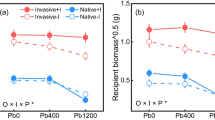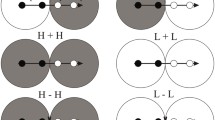Abstract
Physiological integration between ramets can ameliorate the growth and survival of clonal plants in spatially-heterogeneous environments, as ramets from favourable patches can provide support to those found in stressful patches. However, the advantage conferred by clonal integration might also depend on the evolutionary history of plants with regards to the presented stress. Here, we compared the benefit of clonal integration in response to the distribution of a heavy metal as a stress factor, and asked if this benefit would differ between ecotypes that have either undergone selection to tolerate heavy metals or not. In a greenhouse experiment, we grew pairs of connected and severed ramets of the metal hyperaccumulator Arabidopsis halleri, which originated from populations of either metalliferous or non-metalliferous soils. The ramets were grown in paired pots, which were contaminated with cadmium (Cd) either heterogeneously (100 or 0 ppm Cd per pot) or homogenously (50 ppm Cd per each pot). A. halleri ecotypes that originated from non-metalliferous soils performed better when ramets were connected and the distribution of Cd was heterogeneous. However, clonal integration had no effect on the performance of genotypes from metalliferous soils, regardless of the distribution of Cd. These results support the hypothesis that clonal integration is beneficial in stressful environments as long as the stress is patchily distributed, and particularly for plants that did not undergo selection to withstand it.



Similar content being viewed by others
References
Alpert P (1990) Water sharing among ramets in a desert population of Distichlis spicata (Poaceae). Am J Bot 77:1648–1651
Alpert P (1991) Nitrogen sharing among ramets increases clonal growth in Fragaria chiloensis. Ecology 72:69–80
Alpert P (1999) Clonal integration in Fragaria chiloensis differs between populations: ramets from grassland are selfish. Oecologia 120:69–76
Alpert P, Mooney H (1986) Resource sharing among ramets in the clonal herb, Fragaria chiloensis. Oecologia 70:227–233
Armas C, Ordiales R, Pugnaire FI (2004) Measuring plant interactions: a new comparative index. Ecology 85:2682–2686
Baker AJ (1981) Accumulators and excluders-strategies in the response of plants to heavy metals. J Plant Nutr 3:643–654
Baker A (1987) Metal tolerance. New Phytol 106:93–111
Bert V, Macnair M, De Laguerie P et al (2000) Zinc tolerance and accumulation in metallicolous and nonmetallicolous populations of Arabidopsis halleri (Brassicaceae). New Phytol 146:225–233
Bert V, Bonnin I, Saumitou-Laprade P et al (2002) Do Arabidopsis halleri from nonmetallicolous populations accumulate zinc and cadmium more effectively than those from metallicolous populations? New Phytol 155:47–57
Brady KU, Kruckeberg AR, Bradshaw Jr H (2005) Evolutionary ecology of plant adaptation to serpentine soils. Annu Rev Ecol Evol Syst 36:243–266
Caraco T, Kelly CK (1991) On the adaptive value of physiological integraton in clonal plants. Ecology 72:81–93
Chen J-S, Lei N-F, Yu D et al (2006) Differential effects of clonal integration on performance in the stoloniferous herb Duchesnea indica, as growing at two sites with different altitude. Plant Ecol 183:147–156
de Kroon H, Hutchings MJ (1995) Morphological plasticity in clonal plants—the foraging concept reconsidered. J Ecol 83:143–152
Ernst W, Schat H, Verkleij J (1990) Evolutionary biology of metal resistance in Silene vulgaris. Evolut Trends Plants 4:45–51
Gardner SN, Mangel M (1999) Modeling investments in seeds, clonal offspring, and translocation in a clonal plant. Ecology 80:1202–1220
Hartnett D, Bazzaz F (1983) Physiological integration among intraclonal ramets in Solidago canadensis. Ecology 64:779–788
Hutchings M (1999) Clonal plants as cooperative systems: benefits in heterogeneous environments. Plant Species Biol 14:1–10
Hutchings MJ, Wijesinghe DK (1997) Patchy habitats, division of labour and growth dividends in clonal plants. Trends Ecol Evol 12:390–394
Jónsdóttir IS, Callaghan TV (1989) Localized defoliation stress and the movement of 14 C between tillers of Carex bigelowii. Oikos 54:211–219
Kazakou E, Dimitrakopoulos P, Baker A et al (2008) Hypotheses, mechanisms and trade-offs of tolerance and adaptation to serpentine soils: from species to ecosystem level. Biol Rev 83:495–508
Kazemi-Dinan A, Thomaschky S, Stein RJ et al (2014) Zinc and cadmium hyperaccumulation act as deterrents towards specialist herbivores and impede the performance of a generalist herbivore. New Phytol 202:628–639
Kemball W, Marshall C (1995) Clonal integration between parent and branch stolons in white clover: a developmental study. New Phytol 129:513–521
Koivunen S, Saikkonen K, Vuorisalo T et al (2004) Heavy metals modify costs of reproduction and clonal growth in the stoloniferous herb Potentilla anserina. Evol Ecol 18:541–561
Krämer U (2010) Metal hyperaccumulation in plants. Annu Rev Plant Biol 61:517–534
Macnair M (1981) Tolerance of higher plants to toxic materials. In: Bishops J, Cook L (eds) Genetic consequences of man made change. Academic Press, London, pp 177–208
Maestri E, Marmiroli M, Visioli G et al (2010) Metal tolerance and hyperaccumulation: costs and trade-offs between traits and environment. Environ Exp Bot 68:1–13
Nilsson J, D’Hertefeldt T (2007) Origin matters for level of resource sharing in the clonal herb Aegopodium podagraria. Evol Ecol 22:437–448
Outridge P, Hutchinson T (1991) Induction of cadmium tolerance by acclimation transferred between ramets of the clonal fern Salvinia minima Baker. New Phytol 117:597–605
Pauwels M, Frérot H, Bonnin I et al (2006) A broad-scale analysis of population differentiation for Zn tolerance in an emerging model species for tolerance study: Arabidopsis halleri (Brassicaceae). J Evol Biol 19:1838–1850
Pennings SC, Callaway RM (2000) The advantages of clonal integration under different ecological conditions: a community-wide test. Ecology 81:709–716
Price EAC, Hutchings MJ, Marshall C (1996) Causes and consequences of sectoriality in the clonal herb Glechoma hederacea. Vegetatio 127:41–54
Roiloa SR, Retuerto R (2006) Physiological integration ameliorates effects of serpentine soils in the clonal herb Fragaria vesca. Physiol Plant 128:662–676
Roiloa SR, Retuerto R (2012) Clonal integration in Fragaria vesca growing in metal-polluted soils: parents face penalties for establishing their offspring in unsuitable environments. Ecol Res 27:95–106
Roiloa SR, Alpert P, Tharayil N et al (2007) Greater capacity for division of labour in clones of Fragaria chiloensis from patchier habitats. J Ecol 95:397–405
Saitoh T, Seiwa K, Nishiwaki A (2002) Importance of physiological integration of dwarf bamboo to persistence in forest understorey: a field experiment. J Ecol 90:78–85
Salzman AG, Parker MA (1985) Neighbors ameliorate local salinity stress for a rhizomatous plant in a heterogeneous environment. Oecologia 65:273–277
Slade A, Hutchings M (1987) An analysis of the costs and benefits of physiological integration between ramets in the clonal perennial herb Glechoma hederacea. Oecologia 73:425–431
Stuefer JF, During HJ, de Kroon H (1994) High benefits of clonal integration in two stoloniferous species, in response to heterogeneous light environments. J Ecol 82:511–518
Stuefer J, De Kroon H, During H (1996) Exploitation of environmental hetergeneity by spatial division of labor in a clonal plant. Funct Ecol 10:328–334
Sutherland WJ, Stillman RA (1988) The foraging tactics of plants. Oikos 52:239–244
Van Kleunen M, Fischer M, Schmid B (2000) Clonal integration in Ranunculus reptans: by-product or adaptation? J Evol Biol 13:237–248
Van Rossum F, Bonnin I, Stéphane F et al (2004) Spatial genetic structure within a metallicolous population of Arabidopsis halleri, a clonal, self-incompatible and heavy-metal-tolerant species. Mol Ecol 13:2959–2967
Wijesinghe DK, Handel SN (1994) Advantages of clonal growth in heterogeneous habitats: an experiment with Potentilla simplex. J Ecol 82:495–502
Zhao F, Jiang R, Dunham S et al (2006) Cadmium uptake, translocation and tolerance in the hyperaccumulator Arabidopsis halleri. New Phytol 172:646–654
Acknowledgments
We are grateful to Ute Krämer and Ricardo Stein for providing information on A. halleri populations, and to Mira Hoch, Bettina Springer and Anne Rysavy for the collection of A. halleri and soil in the field, the preparation of contaminated soil, and propagation of A. halleri in the greenhouse. We also wish to thank Peter Kühn and Sabine Flaiz from the Physical Geography Department at Tübingen University for the Zn and Cd soil-content analyses, and Jitka Klimešova and two anonymous reviewers for helpful suggestions on the manuscript. This study was supported by the SPP 1529 priority program “Adaptomics” grant of the German Research Foundation (DFG) to KT and MG (TI 338/10-2) and to SC (CL 152/9-2).
Author information
Authors and Affiliations
Corresponding author
Rights and permissions
About this article
Cite this article
Gruntman, M., Anders, C., Mohiley, A. et al. Clonal integration and heavy-metal stress: responses of plants with contrasting evolutionary backgrounds. Evol Ecol 31, 305–316 (2017). https://doi.org/10.1007/s10682-016-9840-9
Received:
Accepted:
Published:
Issue Date:
DOI: https://doi.org/10.1007/s10682-016-9840-9




